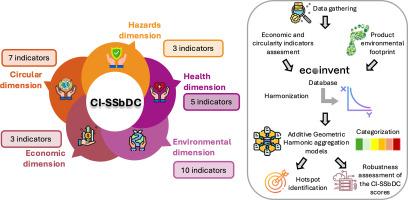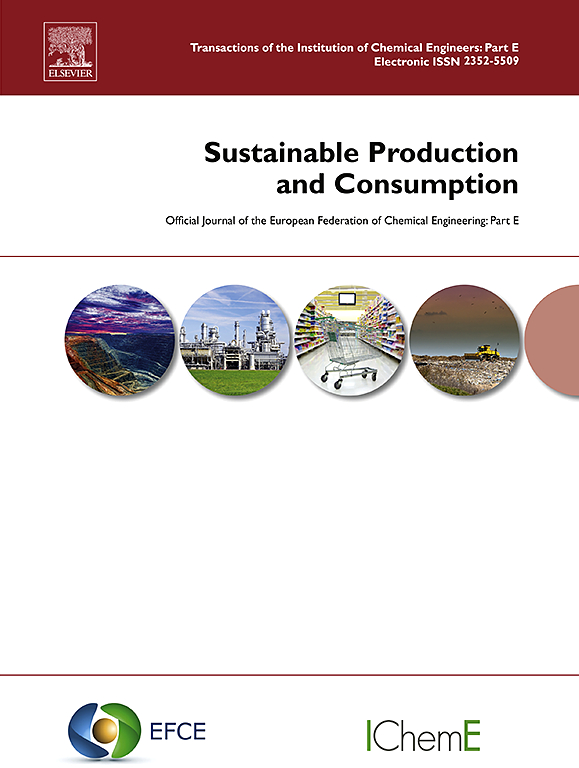通过设计和循环评估新兴技术安全性和可持续性的综合指标
IF 9.6
1区 环境科学与生态学
Q1 ENVIRONMENTAL STUDIES
引用次数: 0
摘要
由于新兴技术(即化学品、生物基产品和其他相关材料制造工艺)的数据有限,而且与传统生产模式相比,这些工艺的优化和实施水平较低,因此将设计安全与可持续发展(SSbD)框架应用于新兴技术面临着巨大挑战。然而,向循环经济的过渡必须建立在更安全、更高效和更可持续的生产模式基础之上。在这篇研究文章中,我们开发了一种稳健的方法来准确评估这些工艺的可持续和循环潜力。该方法以欧盟委员会 SSbD(EC-SSbD)框架指南为基础,提出了一个新的综合指标(CI-SSbDC)。CI-SSbDC 对安全性、可持续性和循环性进行评估,可应用于生物基和化石基产品和技术。CI-SSbDC 指标范围从 0.01 到 1,其中 "0.01 "表示最不可行的方案,"1 "表示最可行的方案。为了研究不同补偿水平对综合指标值的影响,使用了几种汇总方法,包括加法、几何和调和均值。综合指标适用于同一产品的三种生产变体,以证明其有效性和潜力,还包括敏感性分析,以测试方法中的假设的影响。尽管 EC-SSbD 框架仍在不断发展,但所提出的综合指标是将其付诸实践的一个切实可行的初步方法,它整合了对生物经济至关重要的循环性支柱,并与废物管理战略和生命周期分析方法保持一致。此外,它还可以作为第一份指南,突出有效实施 SSbD 和循环性框架的工作重点。本文章由计算机程序翻译,如有差异,请以英文原文为准。

A composite indicator for evaluating safety and sustainability by design and circularity in emerging technologies
The application of the Safe-and-Sustainable-by-Design (SSbD) framework to emerging technologies (i.e. chemicals, bio-based products and other related materials manufacturing processes) faces significant challenges due to the limited data availability of these processes and because their level of optimization and implementation is less developed compared to traditional production models. However, the transition to the circular economy must be based on safer, more efficient and sustainable production models. In this research article, a robust methodology that accurately assesses the sustainable and circular potential of these processes is developed. This methodology proposes a new composite indicator (CI-SSbDC) based on the European Commission SSbD (EC-SSbD) framework guidelines. CI-SSbDC assesses safety, sustainability and circularity, and can be applied to bio-based and fossil-based products and technologies. The CI-SSbDC indicator ranges from 0.01 to 1, where “0.01” indicates the least promising option and “1” the most promising one. To examine how different levels of compensation influence the composite indicator value, several aggregation methods were used, including additive, geometric and harmonic means. The composite indicator was applied to three production variants for the same product, to demonstrate its effectiveness and potential, including also sensitivity analysis to test the influence of the assumptions made in the methodology. Despite the ongoing development of the EC-SSbD framework, the proposed composite indicator serves as a practical initial approach to put it into practice, integrating the critical circularity pillar essential for the bioeconomy and aligning with waste management strategies and life cycle analysis methodologies. Also, it could serve as a first guide to highlight where to focus efforts on for an effective implementation of SSbD and circularity frameworks.
求助全文
通过发布文献求助,成功后即可免费获取论文全文。
去求助
来源期刊

Sustainable Production and Consumption
Environmental Science-Environmental Engineering
CiteScore
17.40
自引率
7.40%
发文量
389
审稿时长
13 days
期刊介绍:
Sustainable production and consumption refers to the production and utilization of goods and services in a way that benefits society, is economically viable, and has minimal environmental impact throughout its entire lifespan. Our journal is dedicated to publishing top-notch interdisciplinary research and practical studies in this emerging field. We take a distinctive approach by examining the interplay between technology, consumption patterns, and policy to identify sustainable solutions for both production and consumption systems.
 求助内容:
求助内容: 应助结果提醒方式:
应助结果提醒方式:


